
This department
only deals with portable sundials equipped
with a compass. We describe in Part 1 the different types developed
between
the 17th
and the 19th century.
You will find technical background information in the 2nd
Part. Concerning the non-magnetic
military
sun compasses
we recommend the excellent essay
by Malcolm Barnfield
The
Sundial Goes to War on the
website
Sundials.
Pic. at left: Hunter-type sundial compass
(manufacturer:
HOULLIOT,
c.1930).
Technical Data: Dia.:
2" / 50 mm;
Depth (clsd.): 20 mm; Height
(scales erected) : 2" / 50 mm.
(Click
on the picture for
enlarged view -
see further down other Houlliot-made models)

In
Nov. 1856, the French jeweller Edme
POPARD
who lived in Paris, rue
Grenetat* n° 3
filed a "Patent" (no. 29,784) that would allow him alone to sell any
fashion article featuring a sundial with a compass. This "patent"
consists of a single short sentence that was completed (with many
errors) in Jan. 1857 (see p. 2) :
"...
pour
une nouvel [sic] application consernant [sic] le
sistème [sic] solaire et de la boussol [sic] les deux
réunis applicable sur les tabatière, pomme de
canne, portemonnaie, bijouterie et tout [sic] autres articles de
fantaisie ect. ect. marquand [sic] l'heure au soleil aussi exactement
qu'une orloge [sic]."
(* reading in French language:
horrible
description by H. de Balzac in
César
Birotteau
Picture
at r.: Patent
(click on image for full view)
See other
examples in the online collections of the
Museum of the
History of Science and of the
National Maritime Museum.
CONTENT
Part 1 - Collection
-
EUROPEAN
DIPTYCH sundials (XVIIth C.)
-
Modern
sundials (XXth C.) - U.S.A.:
SLATER,
ANSONIA
SUNWATCH and
BOYD SUN-TIME;
France,
Austria: maker
W.A.;
Soviet
Union / Russia:
Slepchenko
(слепченко)
-
CHINESE
and KOREAN sundials
-
CRESCENT
sundials
-
EQUINOCTIAL
compasses
(Augsburg type)
-
BION,
Nicolas
-
BUTTERFIELD,
Michael
-
MAGNETIC
DIALS (PANTOCHRONOMETERS)
-
GNOMON
Compasses
-
L'ABEE-LUND'S
WATCH COMPASS
Part
2 - Technical Information
(incl.
User
Directions) and Bibliography
IVORY SUNDIALS / FRANCE


These two-fold ivory sundials are called
Dieppe-style
because they were originally developed and mass produced by Charles
BLOUD in the northern French city of DIEPPE (Normandy) from 1666 on.
His brothers (or sons?) Gabriel and Jacques continued the trade and
were first imitated by Ephraïm Sénécal,
then by Jacques Sénécal (see table 2, center
photograph.
Picture at left: ivory instrument, typical of Ch.
Bloud's workshop although unsigned - France, 17thC.
Picture at right: User's instructions (dated 1653) incl.
computing of the time by night (moon clock) and the high tide (
facsimile
available).
Table 1 - Detail views of the four sides
Table 2 - Various examples.
Tab.
1
|
COMPASS
Background: list of
cities
(Pictures
by
courtesy of J. Frellsen / Fleaglass)
|
PERPETUAL CALENDAR
|
SUNDIAL
Note: pin
gnomon is missing
|
LUNAR
VOLVELLE
(night clock)
|
Some items feature many functions: Italian and Babylonian hours (see
Definitions above), seasons curves and a latitudes table. They have on
top of the lid a universal dial and a polar dial. We find
inside these sundials a vertical and a horizontal dial. Under the
compass is also an analemmatical dial. This device is governed by a
rotating disk with a perpetual calendar.
A very rare spherical item (below) made of ivory features an additional
scale for calculating
the tide times. It comprises two halves, one of which contains the
compass and the
sundial (the folding gnomon is apparently missing) and the opposite one
probably contained another instrument. An
octagonal diptych (
link to pic.)
features the same scales (source: Adler
Planetarium Chicago). Both were probably made by the same
maker in a country with many harbours and/or an important navy
like France or Portugal. The sundial itself was probably like the
instrument (
link to pic)
shown in the collection of the National Maritime Museum
(source: Royal Museums Greenwich).
|
SUNDIAL with COMPASS
Top scale: tide time computer;
Bottom scale: Moon calendar
Pictures
by courtesy of Sh. Daftari
|
SUNDIAL
Note:
the gnomon
is missing
|
EPACT (MOON
CALENDAR) for
1626
Months names
abbreviated: the letter Y stands for J = January, June
& July
|
TIDE COMPUTER
Abbrev. ; DL (die lunae), OR (hora) and QI (quintus)
(for
user instructions ask the curator)
|
Tab.
2
Instrument
with
pendulum
(not signed)
Probably France, late 17th C.

Picture
Jaypee (priv.
coll.). |

DIEPPE style sundial,
late 17th C. built by Sénécal |


LIENHART MILLER
(Pic. at l.: Augsburg, Maximilian Museum, at r.: Vivielle's
catalogue)
B/w
pictures courtesy Cdt
Vivielle's
priv. coll. |
PORTUGUESE SUNDIAL
Wood, ink, paint (19th C.), signed
I.S.
i.e.
Iohannes (Latin for
Joao)
da Silva.
The daylight hours are indicated for Portugal's mean latitude (38-39
deg.)
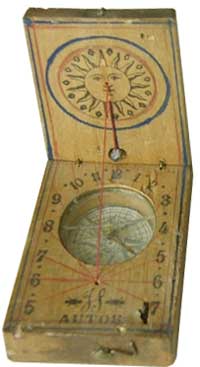 |

The words printed on the rear back face read 'VERDADEIRO AUTOR JOAO DA
SILVA'
(Maker: Joao da Silva).
Note:
This exhibit doesn't
belong to the Online Compass Museum. These pictures were sent by a
friendly visitor (priv. coll.). |
North
is
indicated with a fleur-de-lis
but also EAST with two tiny symbols.
(go to MISCELLANEOUS / Cardinal points)

(Click
on the picture for a
detailed view of the compass).
Technical
data
- Dimensions: 68 x 48 x 14 mm
- Weight: 33 gr
- Pendulum: lead bead
|
SPANISH SUNDIAL
(Replica: go to
Villa Alcor)
CZECH SUNDIAL
Unsigned XVIIIth C. sundial with cardinals in Czech language*
|
|

Pictures courtesy Steinbrich-Fricke
(Click
on images for enlarged views)
* S. Miscellaneous /
Cardinals
|
Technical
Data
- Dimensions: ... mm
- Pendulum: Lead
- Material: wood, ink,
- Date: 1748

|
BRITISH SUNDIALS
GERMAN
SUNDIALS

The two most important manufacturing cities in Germany
were Augsburg (s.
Equinoxial
systems further below) and
Nuremberg. In this city, sundial makers first
produced diptychs
made of ivory like in France (Dieppe) and later simple one made of
paper and wood.
A well-known manufacturer was Ernst Christoph Stockert (
see picture at
left courtesy Frederic Secchi).
There still is a compass manufacturer called
Stockert
in Nuremberg (see also
Marching
compasses). Other German makers:
Beringer, Kleininger etc.
Technical
Data (item at
left):
- Dimensions: 72 x 72 x 11mm (2" 13/16 x 2" 13/16 x 0.433")
- Divisions: only the cardinal points are indicated (in
German). The position of the magnetic needle corresponding to the
declination in those days (late 18th C., i.e.
approx. 15° west) is painted on the bottom.
The gnomon automatically folds back. To read the
time,
one has to push down its lower end with one's thumb.

Modern
Sundials - U.S.A.
Mabel Slater's Patent
Mabel Hunt Slater was a Boston socialite who patented several
inventions, some very ingenious like a system for getting cold
water out of a refrigerator in 1904. This pocket sundial with
integrated compass was patented in 1918. The highly precise drawing
would suggest that it was effectively produced but we havn't seen any
real item.
Click on the image for a 3-side
view.
 SUNWATCH
SUNWATCH
First designed and manufactured
by
THE
ANSONIA CLOCK CO., NEW YORK
USA.
(
Patent
June 6, 1922 by George HOLLINWOOD,
THE ANSONIA CLOCK Co., 7th Av. 12th Street, BROOKLYN, NY) but the model
was later retailed by
Outdoor
Supply Co.
after ANSONIA was sold in 1929 to a Russian company (see the
company's
History).
There were 5 versions. Two for the American market, one for
the Australian/New Zealand market, one for the British market and one
for the Canadian market. The sundial base plate has 3 scales for
telling time in 3 places with different latitudes. The inside cover has
a chart listing 42 cities in the USA and their respective degrees
latitude, longitude and clock time in minutes to add or subtract from
sun time. The brass gnomon is fitted into a crevice in the base plate,
to be pulled out when needed. The various latitudes are etched into the
base of the gnomon for easy use. The Sunwatch is enclosed in a brass
case with a push-button catch at the base (Source: Description by
www.BONANZLE.com).
(Pic.
abore:
advertisement - click for enlarged view)
BOYD
SUN-TIME
This system was patented in 1950 by Francis O. Boyd
und John E. Johanson and manufactured by the JOHANSON
MFG.
CORP BOONTON,
NJ. (click
HERE
to view the patent's fig.). This item features e retailer of this item
was the well-known
Compass -
Instrument and Optical
Company,
268 Fourth Ave. New York 10, N.Y.

Above:
the white element on top of the dial is the gnomon.
It is to be orientated in such a manner that the crest doesn't cast a
shadow on the flat base.
Below:
the manufacturer's signature
 |
The table
of
longitudes
above the sundial

Latitude setting

(Click
on the images for enlarged views)
|

Map of the U.S. with the declination curves in
red

Declination setting
|
Technical
Data
- Case Dimensions: 2" x 1 1/2"
- Compass diameter: 1 1/8" (30mm)
- Metallic case
- Sundial with two possible readings: Standard and Daylight Saving
- Table of longitudes for mainland U.S.A.
- User's instructions : 6 pages ( facsimile can
be ordered).

Concealed under the blue tag of Compass
Instr. &
Opt. Co.:
"Precision Made By
Johanson Mfg. Booton etc..."
|
 FRANCE
FRANCE
1 - Portable sundial in wooden case (
click
on image at right for enlarged full view)
2 - Pendant: B.G. & J.P.M. (full name?) was a French jeweller

|

Pictures by courtesy of Chr. May |

|
Technical Data
- L/W: 6 x 45 mm
- Material: light alloy / tin cast, chromated
(Click on the images for
enlarged views) |
AUSTRIA:
W.A. (logo:
sunrise)
Unknown manufacturer with the initials W.A. and a logo
featuring a sunrise. The month names are indicated in Austrian
German: Jän[ner] for
Januar
(January).
To read the time of the day, the instrument is to be
held
flat. Make sure that the 12 o'clock figure of the disc is facing the
geographic (true) North mark of the compass. Turn the instrument until
the needle's blue north end faces the tiny declination arrow
(between 11 and 12). Place the gnomon bearing bar (missing on this item
- see a sketch of a possible component
HERE) onto
the notches of the locking ring and erect the gnomon. Its
shadow
tells the sun-time at the location - not the exact time in the country!
The clinometer is used to measure the elevation angle of the sun or the
moon etc. above the horizon by aiming at it with the two notches
aligned.
Date of design/production: Magnetic North being indicated on
the
disk half-way beween the figures 11 and 12 and since 1 hour
equals
15 degrees (360°/24h), the declination
equals approximately 7
deg. west, i.e. 1910 for Austria's capital Vienna (result
computed
with the
online programme of
Canada's Natural ressources
Dept.).
Note:
This
item's former owner added
by hand corrections
in red
maybe to take into
account some a
change of location.

Bottom
left: The manufacturer's
initials and logo
|

The clinometer
(90°)
Pictures
courtesy M.
Allouche |

The hour disks
Click
on the images for
enlarged views
|
Technical
Data
- Diam.: mm
- Thickness: mm
- Hour Disks: 5, printed on both faces for 10 periods of the year
- The sunrise logo is almost identical to the Busch Rathenau's
own logo

|
USSR / Russia - I. G. SLEPCHENKO (слепченко)
I. G. Slepchenko designed in the Soviet Union
a sundial with built-in compass described in a booklet
(
карманный компас "KCK",
pocket compass). This instrument featured a
style (gnomon) that was inserted into the crystal above the needle. The
marching course could apparently be set using the graduated crown.

Click on img for drawing of orientation with the sun
(солнце) |

Dial: the months are in Russian but the cardinals in German (O
= Ost for East).
|

Pictures
courtesy M. Ivanov
|
Technical
Data
- Diam.: mm
- Thickness: mm
For det. descr.
click on img. below.

|
This description is far from being complete. See some
general information in the category Nautical Compasses/China.
Further details are still missing.
Thanks for sharing your knowledge with us.
-
Horizontal Sundial with
vertical pin gnomon
(
Reproduction
- click on the link).
-
Vertical Sundial
(Diptych)
KOREAN SUNDIAL
- Two versions are known: a wooden and a brass one. The
only reference available is a
German
book (link to picture). The cardinals on the frame are three
red gems for W, N and E. South ( 南 ,Nán) is a black or blue
gem.

Wooden frame, hours on ivory chapter in Chinese
Click on img. for enlarged views
|

The cardinals are
written in traditional Chinese
North: 北 (Bei)
- East: 東 (Dong)
South: 南 (Nán)
- West: 西 (Xi)
|

Brass frame, hours in Arabic figures
Dim.: 82 x 74 x 105 mm
Picture by courtesy of collection.sciencemuseumgroup.org.uk
|

Detail view of a similar item
with its stones
Pic by courtesy
of J. Gredler
|
This instrument is signed by J[oseph] Jackson who was working
between 1735 and 1760. It was
probably manufactured in about 1750, this assessment
being
based on the style of engraving.
Principle: Maker's or
user’s instructions for sundials of this type are not known
to exist. Basically the crescent gnomon has to be adjusted to the
latitude of the place where it is being used. An adjustment is also
made for the time of year, using the calendar scale, and the instrument
is levelled using the levelling screws and spirit levels. Normally
these kinds of dials do not have a compass, being regarded as
self-orienting, since if the adjustments mentioned are made, the shadow
of the tips of the crescent will fall on the hour scale and the
instrument can simply be turned until this happens. Possibly the
addition of a compass was so that the magnetic variation could be
checked against a noon reading. Examples by English makers are rare, as
this design never seems to have been as popular in the British Isles as
it was in continental Europe.
(Source:
Gloria Clifton, The Royal Observatory, Greenwich, UK)
The exact function of all parts cannot be entirely described.
Your help is needed.
Crescent
sundial signed
J. Jackson, London
(c. 1750)

Technical Data
Dimensions:
12" across x 10" 3/4
tall
Ad for a/c avionics instr.

|
View from
aft

Detail
view of
the calendar around the base plate

(Click
on the images for
enlarged views - All pictures courtesy Scott Meyer)
|
Detail
view of the compass dial. The needle's
pivot
straddling on top of the central level tube is a unique feature.

The maker's signature and angle values

The crescent-shaped hours scales (top ends)

|
Detail
views of individual scales
Hour scale (minutes):

Zodiacal signs

The vernier on the latitude scale

The months scale on the gnomons holding crescent

|
TECHNICAL
DESCRIPTION
(for USER'S INSTRUCTIONS see
Part 2,
bottom)
(Note
- An equinoctial
sundial in a hunter-type pocket compass case is displayed at page top).
This system is assumed to
have been developed in France in
the late
17th C. by a clockmaker living in Auch (South of France) called Rugend.
Like many others, he was forced to emigrate to Germany because of the
religion wars and maybe changed his name into
Rugendas
since we
find
compasses made in Augsburg which are signed
Rugendas.
(Quoted after
Mesures du temps
et de l'Espace -
OLF,
1970)
The typical Augsburg dial consisted of an octagonal or square base with
a large compass set in the centre. The equinoctial ring of the dial was
hinged to the base plate and its gnomon was a narrow rod set at the
centre of a pivoted bar lying across the West-East diameter of the hour
ring. The latitude of the hour ring was set by means of a latitude arm
hinged to the base plate, against whose scale the angle of the
equinoctial ring could be set. The latitudes tables were generally
engraved on the underside of the compass bowl but sometimes printed on
a paper glued inside the lid of the box.

The
magnetic
declination was sometimes
indicated with the letter
E (emendor) on the dial of
some compasses like this Vogler sundial (see pic. at left - courtesy
James P. Frellsen - click to enlarge). Since the declination was
approx. 10°
East in the late
18th C., the E-E line indicates the magnetic North-South
axis.
Note: The cardinals are indicated in Latin Language. S = Septentriones
= North!
We display below two typical items: A mass-produced Vogler and
a high-quality Joseph Anton Schöner.
Andreas Vogler was the brother
of Johann Georg Vogler who had started a
shop in Augsburg in 1740. Andreas took the business over at his
brother's death in
1765 and continued until the 1790's. He died in 1800. They had
specialised in poorly executed, cheap mass production items with crude
design and little accuracy.
(Source: Higton, H. -
Sundials
– an Illustrated
History of Portable Dials
© 2001)
Picture:
print out of
La GNOMONIQUE pratique, Fig. 68
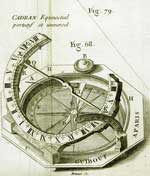
(Click
on the drawing for
an enlarged view) |
German
pocket instrument

(Picture
courtesy Jaypee -
Click on the picture for
an
enlarged view) |
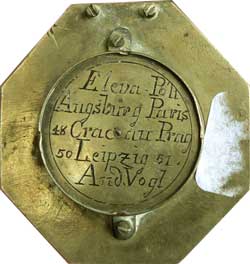
Reverse: the latitudes of a few cities* and Andreas
VOGLER's signature abbreviated
"And. Vogl".
Eleva Poli = Elevatio Poliarum (latitude of cities)
Augsburg Paris 48, Cracau (Kracow), Prag (Prague) 50, Leipzig
51
|
Luxurious
gilt instrument
View from the
side
(hour
ring
fully erected for the photograph)

Pictures
courtesy Efim Tulchinsky -
Click for enlarged views |
Top
view showing the
maker's signature: Joseph Anton Schöner
The dial features cardinals in Latin language (see Miscellaneous /
Cardinals / Latin)
The pendulum ensuring an horizontal position:

|
City
names on
reverse:
- OFEN is the old German name of Budapest. Pest is the Hungarian form
of the former slav name Pecs
meaning "oven". This was probably the safe
place on the other bank of the Danube river where the city's bread used
to be baked.
- St
Maura
was a fortress near Istanbul
(Picture courtesy
www.vintage-maps.com)
Other names: Ceftalonia,
Spalatro: see WIKIPEDIA
Note: A dash was engraved above a letter in the place a
following "n" or
"m" (like in Dresde-n, Amsterda-m and Cölle-n =
Köln/Cologne) left for place reasons.

|
Other
equinoctial
compasses
Petrus
GRAECIUS (1593)


Pictures
courtesy
C.N.
|

- Dim.: 50 x 50 x 20 mm

Click on img. for full view of the Latin
motto around the case
|

Cities in Latin America
|

Cities in Europe
|
 |

|
High
precision
instrument with two levels and three levelling screws made by F.
BARKER & Son (1919).
The latitudes scale reaches from zero to 90° so that
this instrument can be used from the equator to the poles. |

Instrument with one level,
SECRETAN
(c1930)
See also DUCATILLON |
Instr. unsigned, c1830*, divisions: +/-30° on
either side of North ref. Dim. box: 85 x 85mm, compass Ø
75mm. A smaller similar instr.
(Ø 50 mm). The hours are also engraved inside the chapter. Very low serial
number: 2 (links
to pics.)
*
Date
calculated on the base of the magn. dev. engraved:
22° W
|

Instrument probably built by HOULLIOT
in the
middle of the 20th c. Some items featured city
names (link to
a pic with
Chinese
names, picture courtesy of mogoshow and priv. coll. Houlliot).
(Click
on image at left
and
above for enlarged view of dial) |
Unknown French maker
Late 19th c.
This model doesn't feature an erectible side scale for
latitudes but instead a dial graduated 10-80 with a pointer.


|

Internal gear system
The
enlarged view shows the matching gear wheel at the internal end of the
pendant
|
Technical Data
- Dia.: 65 mm
- Wt.: 115 gr
- City names in French:
Rome 42, Londres 51, New York 41, Paris 49, Vienne 48, Berlin 52.
- Link to a description
of the dial operation
|

Similar instrument made by
Sal. KRIGNER,
18th c.
Math.-Physik. Salon Dresde
|
Nicolas BION (1652-1735) was a French mathematician. His shop
was located
in Paris, Quai de l'Horloge du Palais.
He wrote a famous book on mathematical instruments called
Traité
de la construction et des principaux usages des instruments de
mathématique and Butterfield-type
compasses.
WARNING
- Beware of
FAKES!
(click
on link for
pictures)
Several major museums have confirmed that contemporary
reproductions are
currently available - usually on eBay. These are only worthless museum
gift shop
items and not original antique items. You can easily recognize
them by the gross engraving of the latitudes (40-50-60) on the gnomon's
adjustable blade. Send us pictures if you are unsure.
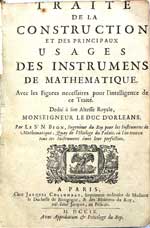 |
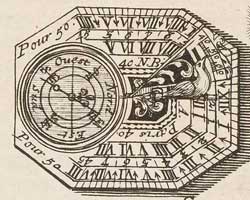
N.
BION showed in his book a sundial with
his name as the maker on page 362. |
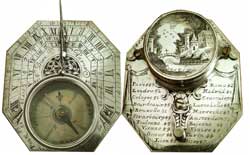
Picture
courtesy T. Kloss
A
drawing (flower or landscape)
was engraved on some Bion dials' rearside
Note:
the needle and 2
screws on this compass are not genuine!
|

Descr. in a 1984 auction
catalogue
Transl.:
Butterfield-type sundial signed N. BION. Late cXVII - early cXVIII.
List of 24 French, Italian and European cities located between 40 and
55 deg. north.
|
PROFILE - Michael Butterfield (1635-1724) was a British clockmaker who
settled in Paris
about the year 1663. He worked for the royal court of France and was
appointed engineer to the King. He opened in the district
faubourg
Saint-Germain, in the street
rue
Neuve-des-Fossés, a
shop for precision
instruments. His shop's sign read
AUX
ARMES D'ANGLETERRE
(at the sign of England's
coat of arms, 1st mention in 1677). Russia's Czar Peter the Great
visited his shop in 1717 and
ordered a great quantity of dials made of gilt copper. After
Butterfield's death
in 1724, the sun-watch type he had been manufacturing and selling was
copied by many european manufacturers.
Description
The Butterfield dial is a type of semi-universal horizontal dial, that
is, a horizontal dial which can be used in a number of different
latitudes, but not in the full range from 0° to 90°. It
is
generally either octagonal or oval in shape and is almost always marked
with three or four different hour scales, each of which is marked with
a specific latitude. The essentials of the Butterfield sundial are
a dial plate engraved with a number of different hour scales serving
different latitudes, a compass, and an adjustable gnomon. The gnomon is
marked with a latitude
scale and it can move within the bird index which marks the latitude
angle against the scale.
It was not B. who originally designed these instruments. Examples are
known which clearly date from before the time that Butterfield began
working in Paris. Earlier items known were made by
Roch
Blondeau (dated 1673), but also by Timothée Collet.
The fact that Butterfield used a bird-shaped pointer on the gnomon
probably made his sundials highly fashionable and he soon achieved a
monopolistic situation on the market.
(Source:
Higton, H.
“Sundials – an Illustrated
History of Portable Dials” © 2001)
Pictures below: Late 17th, early 18 Century
silver horizontal
"Butterfield Sundial"
CADRAN SOLAIRE
FANTAISISTE (20e s.)
 
Pictures by courtesy
of M. van den Berg
|

Click
on the images
for
enlarged views
|
 Technical Data Technical Data
- Dim.: 220 x 160 mm
- Material: tin
- The magnetic needle is a typical simple one used for the
German Bézard compass Mod. I without the
luminous paint,
- Manufactured: probably in the 1920s/30s
- Lint to a view of the hallmark (sort of coat
of arms)
- The style features four latitude notches.
- Engraved words under the style: HORAS NON NUMERO NISI SERENAS (I
only count the happy hours)
|

This item looks at 1st sight like a Butterfield-type sundial
but features no hours chapter on which the animal's shadow would point.
Moreover, zodiac signs engraved in a circle on the face
suggest it
was rather intended for an astrological use. A freely
rotating pointer is attached at the center of the face where
the
animal-shaped gnomon rotates.The use of this instrument is unknown. It
is described in the section Religion & Esoticism / Islam /
Astrology.
Description
A pantochronometer is a Horizontal Magnetic Dial, i.e. a floating
sundial on a compass card. The
rotating card automatically aligns itself along a north-south
axis. The system was already in use in the 18th C.
Collectors & museums refer to pantochronometers as "Magnetic
Dials". The term
pantochronometer was
apparently coined in the
early 19th century by Charles Essex
& Co, 28 Gloucester-Street, Clerkenwell, London (see
ads published in 1825).
Most makers referred to,
or labeled them as,
"Magnetic Dial" {Porter
for example}. Few others referred to, or labeled them also as
pantochronometer, and delivered usually, but not always, together with
EOT tables (Equation of
Time).
Magnetic Dial Problems
- The usage is limited to the latitude determined for the dial.
- Declination / variation could not be altered/adapted. All
sundials must be oriented to TRUE NORTH, never magnetic north. When
made, declination / variation values would be applied to the card. Over
time (less than 10 years) declination / variation values shift (either
west or east) thus rendering the dial inaccurate.

|

Pictures
courtesy weezie24
|

|
Technical
Data
- Dia.: 57mm
- Height (without lid): 37mm
Maker: Stockert, Germany, late 18th C.
(probably Johann Paul - see also above
German sundials)
(Click
on the pictures for
enlarged views) |
PROFILE - ... (C. R.) was a French sundial maker ... ?

|
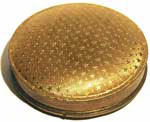
|

|
Technical
Data
- Diameter: 55mm
- Depth (with lid on): 20mm
- Weight: 34gr
- Material: Gilt light alloy
France, late 19th C.
(Click
on the pictures for
enlarged views) |

(Click on the pictures for
enlarged views)
|
Russian
pocket sundial with domed glass

|
Technical
Data
- Diameter: 40mm
- Depth: 14mm
- Weight: 18gr
- Early 20th C.
- Cardinals written in old Russian (compare with
Miscellaneous /
Cardinal points / Russian)
|

Picture courtesy private
coll.
(Click on the pictures for
enlarged views) |
 |
RÜTER
UHR (watch)
Type no. 5 - Berlin
Technical
Data
- Dia.: 50mm / 2 in.
- Height: 25mm / 1 in.
- Materials: the gnomon, two
adjustable magnetized razor blades
and the disk were attached
together with a pressure button and placed on top of a
grammophone needle (click
on link for picture, "Neues Universum").
- Manufactured: Summer 1946, shown in a weekly news (Wochenschau) footage.
Dwg. at left: Principle of the two hour rings for Winter and
Summer hours
(Winterzeit
WZ and Sommerzeit SZ)
and the
magnetic declination
scale. User instr. and techn. descr. in German available (s.
SHOP). |
 |
 |
Patent
(no.
2,594,600, April 29, 1952)
filed by BERKE
Brothers Distilleries Inc. Boston, Mass. for a sundial-compass designed
to be placed on top of bottles
(link to side view) or attached
by a strap to
the wrist.
|
 |
 |
Patent
(Germany, no. 890,627, 1953)
filed by Erichs VIESTURS of York, Pa, USA for a sundial-compass
designed
to be carried like a wrist watch. Three possible versions are described. |
PROFILE - C. R. (name ?) was a French sundial maker

|

|
Technical
Data
- Diameter: 55mm
- Depth (without lid, gnomon erected): 22mm
- Weight: 35gr
- Material: brass case, paper dial
France, late 19th C.
(Click
on the pictures for
enlarged views) |

PROFILE - Johan Henrik L'Abée Lund of Christiana was a Norwegian
engineer.
He patented this design in 1914 in Norway. The patent for
Switzerland (
no. 72,0181,
link to pic) was
granted in 1916. It was manufactured from approx. 1922 to the
late 30's.
The
name
Uhr-Kompass
means "watch compass", and was meant quite
literally: It could be used as a sundial, with the use of the
table on the backside. The red little ant was a part of a promotion
gimmick. In these days
every product should have a marketing slogan, and for this compass it
was "
Kjøp
kompassen med Mauren
i syd" i.e. "Buy the compass
with the ant
pointing south", refering to the well-known fact that in the
woods you can find approximately South by
looking at what side of the trees the ants build their hill.
L'Abée Lund also published a 20-page booklet called "
På
Ski
Med Kart og Kompass" (Cross-country Skiing with map and
compass).
Subtitle: "23 gode regler for fjellturer" (23 good rules for mountain
hikers).
(Note: Quoted
partly from the website
http://www.purgatory.net/kornelia/compass/compass.htm)
Picture at right: the south-pointing red ant

On the early version
the needle featured the cardinals (N and S on a tiny brass tab, see pic
at r.).
The
bezel is secured by means of a wire in a groove (left protruding only
for
the photograph above).
Link to a photograph of the dismantled instrument.
(Click
on the pictures for
enlarged views)
|


On
the case
side is a scale reaching from 0-10 beginning at ESE (130°) and
finishing at WSW (240°).
|
Technical
Data
- Diameter: 50mm
- Depth: 12mm
- Weight: 65gr

The user instructions (4 p., Norwegian)

Pic.
courtesy K.
Takacs
|
COMBINED
INSTRUMENT:
COMPASS (based on the sun's position) & BINOCULAR
Origin: Germany (ca. 1930-1940), model
FAVORIT
/
D.R.G.M. (reg. trade mark).
Folding binocular with sundial. A device shaped like a bottle opener
serves to lock in folded position the small spring loaded lenses.
User's instructions for the sundial-compass: The dial shows the hours
of the longest possible summer day in Northern Germany (i.e from 3 in
the morning to 10 in the evening) together with the cardinal points. To
orientate the compass, one has to rotate the arrow so that the current
hour (indicated by a watch) appears in the arrow's fork end. One turns
then the compass with the arrow head pointing towards the sun. Example:
at noon, the sun is in the South.
Like on all other
opera
glasses (shown in the category
OTHER COMPASSES), there is a
mirror on the face opposite to the dial.
 |
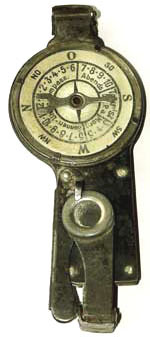
Click on the picture for enlarged view of dial |
Technical
Data
- Length folded: 105mm
- Compass dia.: 40mm
Indications on the dial:
- Sonnen-Uhr & Kompass (sundial and compass)
- Abends (afternoon)
- Morg. (morning)
- Tourist / D.R.P.a. (Pat. pending)
Concerning the meaning of Tourist
in German in
those years, and the abbreviations, see MISCELLANEOUS / GLOSSARY.
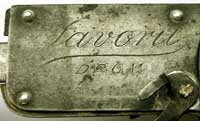
|
Pocket
Hunter Sundials
Hunter type compass types with foldable Butterfield-type,
bird-shaped gnomon.
It
appears in a 1932 catalogue of the French company S-L (see
category Pocket
Compasses) but was manufactured by
Houlliot.
Pendant hold closed with the neck-lace chain
 |
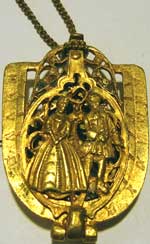
|
Replica
of an antique
instrument
Technical data
- Dimensions: 50 x 38 x 13 mm
- Weight: 35 gr
(Click
on the pictures for
enlarged views) |
GENERAL INFORMATION about astronomy and sundial technique necessary to
understand their functioning
 The
Physical Principle
The
Physical Principle
A sundial is a reduced representation of the
Earth. The sun's light rays impact the instrument exactly like
the globe. This is why the sundial first has to be
orientated. This can be done by means of the
integrated
compass but one must take the magnetic
declination
(the difference
between Magnetic North and True
North) into account. The gnomon (
see
definitions below)
must point towards the Earth’s celestial pole – or
– in line
& parallel to the Earth's axis, towards the North Star* ... if
one could see it during the day hours!
On some dials bult in the18th c. the declination was indicated by means
of a additional line between two letters E (for
emendo
=
correction in Latin - see pic. at right).
*
The North
Star
and Latitude
The
angular height of the North Star {in degrees} above the horizon is the
same as your latitude in degrees. The North Star is on the horizon at
0° latitude and not visible South of the Equator but even at
10° N. latitude {and below} the North Star may not be visible
on even the clearest nights due to atmospheric haze.
The
sundials'
components
The Gnomon
– Blade, Pin or String
The hour is told by the
shadow of a device called
a
gnomon.
There are three different types:
-
Pin Gnomons
are fixed – whereas,
blade
and
string
gnomons can
be fixed or adjustable.
On fixed gnomons, the pitch or angle is the latitude at which the
sundial was made.
Sundials used at higher latitudes have a steep angle. Sundials
used near the equator – or lower latitudes have a
shallow angle.
-
Adjustable Gnomons
can range anywhere from 0° to 90° (example: Barker,
above).
-
String Gnomons
- The string can be fixed for one mean latitude or adjustable
(example: German sundial above).
Fixed
Blade Gnomons usually
have a simple hinge to lay them on the side when closed. Their slope is
a mean value for a limited area (Mediterranean, Central Europe) and
doesn't allow precise time telling.
Adjustable
Blade
Gnomons
Such gnomons generally consist of an adjustable quadrant
engraved on one side
of a
folding hinged blade gnomon supported by a bird-shaped fitting
(duckling).
The dial chapter includes several (2-4) sets
of engraved
or painted scales
alternating in Roman and Arabic numeral made for different latitudes.
This sundial type is adjustable for latitude
by increasing or
decreasing the angle of the blade gnomon against the bird's
beak . The
shadow's border line on one of the appropriate dials for the different
latitudes determines the actual time.
The compass
Pocket sundials incorporate a very simple recessed compass.
The
Latitude Scale
On nautical or professional equinoctial compasses for explorers, which
have to be usable in the entire world, the latitude scale must be
representative of any location on Earth. It is thus graduated
from 0° to 90°, covering a full
hemisphere.
On pocket sunwatches, it just needs to cover the area in which it is
intended to be used. The span typically measures hence only about 20
degrees in Europe (
38-56
on the German compass above).
This is enough to cover a
zone reaching from Portugal to Scotland or 30-50 in the US
(New Orleans to Quebec).
 TELLING THE TIME
TELLING THE TIME
Hour chapters
are usually divided into 5 ~ 15 minute increments.
Read left to right - from morning hours {4 am on the example at left}
to afternoon hours {8
pm}
with 12 (noon) typically in the middle (South). If a sundial is set-up
correctly – the shadow cast by the gnomon onto the hour ring
will give the time of day.
Note - Sundial Time is
Different than Watch Time!
A sundial disregards time
zones. These change
every 15
degrees (time meridians), this value resulting from the Earth's
circumference (360°) divided by 24 hours (one day or
one Earth
rotation). Sundial Noon is defined as when the Sun is directly
overhead, not when
a watch says it is noon. The difference here is the user's distance
(east or west) from a time meridian {longitude}. This
difference can be
as much as 30 minutes if you are exactly between two time meridians.
Since there are 1440 minutes in 24 hours, one minute equals (1440/360)
four degrees of longitude (15 seconds per degree). The Prime Meridian
or 0° longitude runs through Greenwich, the opposite,
being
the International Dateline at 180°. The full hour is thus only
to
be read at places located exactly on a multiple of 15°
i.e. 30, 45, 60, 75, 90, 105, 120, 135, 150, 165 and 180
degrees
west and east). Since the Earth (seen from above the North pole)
rotates counter-clockwise, the sun apparently moves from east to west.
Within a defined time zone, an observer has to add one minute
per four-degree step to (or subtract from) the next
"full-hour spot", depending on whether he stands west
or east
of this location i.e. before or after the sun traverses it at
noon. Example: an observer located at 92°
west
longitude must add 8 minutes to sundial time to correct to
clock
time, Another one located at 88° west longitude would
have to
subtract 8 minutes.
Moreover, many time meridians follow the political borders of
countries.
Another factor to sundial time is the
Equation
of Time
where in some
months of the year, time appears “fast” and in
other months time appears “slow”, this being caused
by the Earth's elliptical orbit around the sun.
Ancient
Definitions of
the Hours:
There has been several methods for counting the duration of a day:
-
Judaic or antic
hours: 12 hours from sunrise to
sunset and 12 hours from sunset to sunrise. They were only twice in the
course of the year of equal length, on March 22 and September 22
(equinox)
-
Italic
hours: 24 hours of equal length from
sunrise until the next sunrise
-
Babylonic
hours: 24 hours of equal length from
sunset until the next sunset
-
Astronomical
hours: 24 hours of equal length
counted from noon until noon on the next day.
USER
DIRECTIONS
A - Equinoctial Sundial
1} Place sundial on a flat
level surface = parallel to the
horizon (if applicable: acting on the screws to center the
level
bubble).
2} Set the latitude of the hour ring (example: London = 51°,
New Orleans 30°, Toronto 45°).
3} Lift the gnomon to 90° angle from the hour ring (sometimes
also called chapter ring).
4} Orient the magnetic needle North to local
declination.
B
- Base Plate
- Sundials with String (2a) or Blade (2b) Gnomon
1} Place sundial on a flat level surface.
2a} STRING - Erect the cover lid vertically so that the string is
pulled
tight with no sagging. If applicable, set the string to the relevant
latitude of your current location. Select the nearest
city indicated on the reverse side.
2b} BLADE - Adjust the blade's scale against the bird's beak according
to the latitude of the nearest city indicated at the underside.
3} Orient the magnetic needle North to local declination
.
BIBLIOGRAPHY
- Gatty, Mrs. A. K. "The Book of
Sundials." - Edit by H.K.P. Edens & E. Lloyd.
© 1872 - Fourth ed. 1900
- Gouk, P. "The Ivory Sundials of Nuremberg 1500-1700”
© 1988
- Higton, H. “Sundials – an Illustrated History of
Portable Dials” © 2001
- Lloyd, S.A. ”Ivory Diptych Sundials 1570-1750”
© 1992
- Marshall, R.K. “Sundials” © 1963
- Waugh, A.E. “Sundials – Their Theory &
Construction” © 1973

Ancient French books dealing with the theory and
technique of sundials:
- Traité de la CONSTRUCTION et des principaux
usages des
INSTRUMENTS de MATHEMATIQUES by Nicolas BION (1709, see below)
- Traité de GNOMONIQUE PRATIQUE by Dom
François Bedos de Celles (1709, picture at right),
- Traité
de la
Construction et des
principaux usages des instruments
de
mathématique (N.
BION)
- Traité d'HORLOGIOGRAPHIE de Dom Pierre de Sainte
Marie-Madeleine (1701).
Contemporary books addressing more collectors and describing
items
displayed in Museums and private collections:
-
Anciennes
INDUSTRIES scientifiques et artistiques DIEPPOISES
(55 p.) 1904, by Ambroise MILET, chap. II: Cadrans
à boussole.
-
LES MONTRES SOLAIRES
- Booklet of about
30 pages
written in 1932 by Commandant VIVIELLE, Head of the French Navy's
Library and private collector. This booklet gives valuable information
about the different sundial types and the life of the makers.
(Photocopies
can be ordered),
-
LES
INSTRUMENTS DES
SCIENCES (Sté fr.
du Livre, 1966),
-
MESURES
DU TEMPS ET DE
L'ESPACE (Off. du Livre,
Fribourg, 1970).
We reproduced here some pictures of items seen in the older ones and we
used some technical definitions and historical facts concerning the
items. You will find find more information about this topic (in French
and German) on the following website:
Gnonomik
 This department
only deals with portable sundials equipped
with a compass. We describe in Part 1 the different types developed
between
the 17th
and the 19th century.
You will find technical background information in the 2nd
Part. Concerning the non-magnetic military
sun compasses
we recommend the excellent essay
by Malcolm Barnfield The
Sundial Goes to War on the
website
Sundials.
This department
only deals with portable sundials equipped
with a compass. We describe in Part 1 the different types developed
between
the 17th
and the 19th century.
You will find technical background information in the 2nd
Part. Concerning the non-magnetic military
sun compasses
we recommend the excellent essay
by Malcolm Barnfield The
Sundial Goes to War on the
website
Sundials. In
Nov. 1856, the French jeweller Edme POPARD
who lived in Paris, rue
Grenetat* n° 3
filed a "Patent" (no. 29,784) that would allow him alone to sell any
fashion article featuring a sundial with a compass. This "patent"
consists of a single short sentence that was completed (with many
errors) in Jan. 1857 (see p. 2) :
"... pour
une nouvel [sic] application consernant [sic] le
sistème [sic] solaire et de la boussol [sic] les deux
réunis applicable sur les tabatière, pomme de
canne, portemonnaie, bijouterie et tout [sic] autres articles de
fantaisie ect. ect. marquand [sic] l'heure au soleil aussi exactement
qu'une orloge [sic]."
In
Nov. 1856, the French jeweller Edme POPARD
who lived in Paris, rue
Grenetat* n° 3
filed a "Patent" (no. 29,784) that would allow him alone to sell any
fashion article featuring a sundial with a compass. This "patent"
consists of a single short sentence that was completed (with many
errors) in Jan. 1857 (see p. 2) :
"... pour
une nouvel [sic] application consernant [sic] le
sistème [sic] solaire et de la boussol [sic] les deux
réunis applicable sur les tabatière, pomme de
canne, portemonnaie, bijouterie et tout [sic] autres articles de
fantaisie ect. ect. marquand [sic] l'heure au soleil aussi exactement
qu'une orloge [sic]."

 These two-fold ivory sundials are called Dieppe-style
because they were originally developed and mass produced by Charles
BLOUD in the northern French city of DIEPPE (Normandy) from 1666 on.
His brothers (or sons?) Gabriel and Jacques continued the trade and
were first imitated by Ephraïm Sénécal,
then by Jacques Sénécal (see table 2, center
photograph.
These two-fold ivory sundials are called Dieppe-style
because they were originally developed and mass produced by Charles
BLOUD in the northern French city of DIEPPE (Normandy) from 1666 on.
His brothers (or sons?) Gabriel and Jacques continued the trade and
were first imitated by Ephraïm Sénécal,
then by Jacques Sénécal (see table 2, center
photograph.


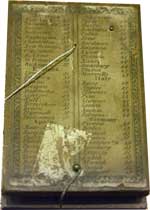







 The two most important manufacturing cities in Germany
were Augsburg (s. Equinoxial
systems further below) and
Nuremberg. In this city, sundial makers first
produced diptychs
made of ivory like in France (Dieppe) and later simple one made of
paper and wood.
A well-known manufacturer was Ernst Christoph Stockert (see picture at
left courtesy Frederic Secchi).
There still is a compass manufacturer called Stockert
in Nuremberg (see also Marching
compasses). Other German makers:
Beringer, Kleininger etc.
The two most important manufacturing cities in Germany
were Augsburg (s. Equinoxial
systems further below) and
Nuremberg. In this city, sundial makers first
produced diptychs
made of ivory like in France (Dieppe) and later simple one made of
paper and wood.
A well-known manufacturer was Ernst Christoph Stockert (see picture at
left courtesy Frederic Secchi).
There still is a compass manufacturer called Stockert
in Nuremberg (see also Marching
compasses). Other German makers:
Beringer, Kleininger etc.
 SUNWATCH
SUNWATCH








 The magnetic
declination was sometimes
indicated with the letter
E (emendor) on the dial of
some compasses like this Vogler sundial (see pic. at left - courtesy
James P. Frellsen - click to enlarge). Since the declination was
approx. 10°
East in the late
18th C., the E-E line indicates the magnetic North-South
axis.
The magnetic
declination was sometimes
indicated with the letter
E (emendor) on the dial of
some compasses like this Vogler sundial (see pic. at left - courtesy
James P. Frellsen - click to enlarge). Since the declination was
approx. 10°
East in the late
18th C., the E-E line indicates the magnetic North-South
axis. 






















 Technical Data
Technical Data













 PROFILE - Johan Henrik L'Abée Lund of Christiana was a Norwegian
engineer.
He patented this design in 1914 in Norway. The patent for
Switzerland (no. 72,0181, link to pic) was
granted in 1916. It was manufactured from approx. 1922 to the
late 30's.
PROFILE - Johan Henrik L'Abée Lund of Christiana was a Norwegian
engineer.
He patented this design in 1914 in Norway. The patent for
Switzerland (no. 72,0181, link to pic) was
granted in 1916. It was manufactured from approx. 1922 to the
late 30's. 






 The
Physical Principle
The
Physical Principle TELLING THE TIME
TELLING THE TIME  Ancient French books dealing with the theory and
technique of sundials:
Ancient French books dealing with the theory and
technique of sundials: